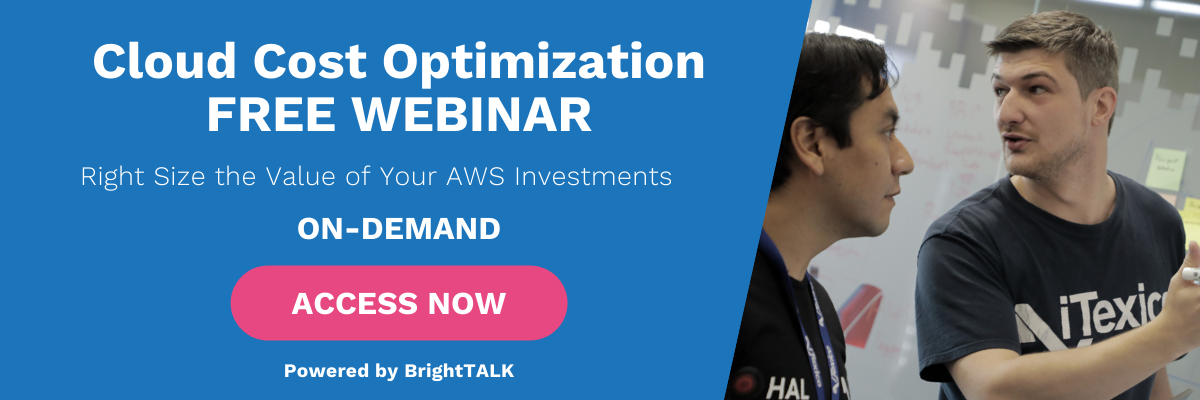Cloud Computing Services Explained | iTexico
Isn’t it neat how we’re able to access everything we need for work or recreation from just about anywhere with a Wi-Fi connection? It’s still within recent memory where, if you wanted to really get some work done for your company, you’d have to be locked in a box to do it. Relying on hardware alone isn’t the standard anymore.
What Are Cloud Services?
Cloud computing services have brought a platform to organizations worldwide for a better, safer, more cost-efficient software development process. It’s main goal is to facilitate using programs and accessing data by keeping them off an individual’s local hard drive. By that motion, a whole slew of benefits are derived by utilizing the intangible nature of the cloud.
Without going too much into detail, let’s name off a few of the bennies cloud computing offers. With the internet as the conduit, employees can access their work from anywhere their heart desires, from home to an entirely different continent. Storage on the cloud offers security redundancies, offering new avenues for backing up your most important work easily. Tack on increased connectivity, cost-efficiency, increased productivity, and so on so forth, and you’ve got more than enough decent reasons to give it a shot.
Cloud services are broken up into three categories: Infrastructure-as-a-Service (IaaS), Platform-as-a-Service (PaaS), and Software-as-a-Service (Saas). There’s no one golden egg that can fill every niche for every company, meaning you’ll have to research and come to your own conclusions regarding which cloud service is right for you. They all have their own strengths, leaving each category with their own particular flavor of company for cloud app development.
Infrastructure-as-a-Service (IaaS)
You may not want to fuss with the man hours necessary to build up an app’s infrastructure from the ground up. Rather than starting with just a hammer, nails, and a few planks of wood, IaaS is essentially providing you with the entire framework for you to work with while developing your product. That’s what it means for cloud computing to be an Infrastructure-as-a-Service: to provide the “Infrastructure” as the “Service”.
As an IaaS, the cloud computing service allows users to run programs off a remote server. By virtue of this style of cloud service, you gain several benefits. For one, allowing a third-party to have control over your infrastructure means you won’t need to be bothered about maintenance and upkeep on said infrastructure.
If time freed up from intensive server maintenance wasn’t enough, you’ll also find your organization sporting a heftier wallet. Since it’s a third-party handling the details of infrastructure, organizations are allowed exemption from having to pay for expensive hardware for each individual, providing them with access to data and programs remotely.
What’s most desirable about this type of service is the flexibility and customizability it provides for you. While the provider is supplying you with the means for your product’s infrastructure, the service is entirely client-controlled, only restricted by what resources you decide to expend to use it, which also factors into its overall cost. This way, however, the client is afforded complete and utter control over their own infrastructure.
There’s plenty of leniency to flaunt for your company regarding maintenance, but you’ve plenty of responsibilities of your own regarding infrastructure. Since you’re in control, there are aspects of the service that must be maintained by the client organization in question. Some of these include the following:
- Applications
- Data
- Runtime
- Operating system
- Security
Not everything is left in the third-party’s hands, nor would you realistically want that. However, like we’ve said before, you might not feel compelled to be concerned about certain other aspects, allowing you to focus your attention on more important parts of your work. Some of these aspects that are handled by the cloud service provider are as follows:
- Virtualization
- Servers
- Storage
- Networking
With separation of duties, the functionality of a company can expand. Like we mentioned, you can use the resources freed up by not having to work on server maintenance and other assorted aspects and put them toward your product. That is to say, your organization will enjoy more overall flexibility and an increased ability to be scalable in the future.
Examples of IaaS
IaaS prides itself as the most customizable and flexible option, leading many organizations view it as a solution that fits like a glove for their needs. Extended scalability provides a means to adapt and grow with a thriving business, while flexibility provides the necessary resources to address app necessities, employee work routines, and so on.
The following notable organizations are some of the myriad examples of successful IaaS as a cloud computing service:
- Rackspace
- Google Compute Engine
- Elastic Compute Cloud
- Digital Ocean
Platforms-as-a-Service (PaaS)
IaaS is for the companies that want the greatest possible control over the function of their product. Platforms-as-a-Service is essentially the next level down, compromising control for ease of use. You won’t have the means to tweak every aspect of your infrastructure in exchange for having a pre-built platform provided to you as the service. Hence the “Platform” is the “Service” in this instance.
Let’s elaborate more about that. PaaS is about providing a platform to build custom apps online that are delivered through the internet. With a foundation provided, all the client is required to do is focus entirely on the software itself. Yes, that’s correct, most of the infrastructure minutiae and other things that come with maintaining the system is handled by the third-party rather than your company.
That sounds great, right? Well, it is, but not for everyone. Remember that there’s an equal exchange here, where you forfeit a hefty amount of independence regarding the development of your product in exchange for responsibilities being handled by someone else. You’re given a sort of freedom of movement in that sense.
The freedom of movement comes from being able to focus solely and entirely on the quality and performance of your product. You’ll have more time to code, test, and deploy applications while being free to not have to worry about managing security patches, operating system updates, and the maintenance of your infrastructure. Depending on what kind of company you are, that may be just be the ticket you’re looking for.
Examples of PaaS
PaaS has been experiencing a rapid growth of popularity as of late. The flexibility provided with IaaS is great, but many companies can afford to shrug off the hassle and opt for PaaS as an alternative. With specially designed components for the construction of any app, PaaS retains the kind of scalability and availability required to create functional, effective apps.
The following is a short list of companies that provide PaaS cloud computing services:
- Apache Stratos
- Google App Engine
- OpenShift
- Microsoft Azure
Software-as-a-Service (SaaS)
The final category among cloud computing services is Software-as-a-Service, which represents the natural extension from IaaS to Paas. The main difference between IaaS and Paas was in their responsibilities, how much a third-party would handle the workload for a company. SaaS is the epitome of the client-side software focus, wherein virtually every responsibility involved in the product’s infrastructure is of no consequence to the company.
SaaS is about software distribution in which a service provider hosts a program on their server while providing access to customers. Essentially, you’re being given a password and allowed to use their program to develop your own product. It’s directly provided through the web browser, making it easily accessible and freely available online. Since you’re not being provided with the platform or infrastructure themselves, all there is to be concerned about is the software itself.
With the web browser being the conduit of choice for this cloud computing service, SaaS has become the most commonly used category of the three. You don’t need to download anything, or worry about frequent updates, leaving your employees to enjoy a variety of different developer tools as the key to success for cross platform development. There are several tools that do this using different programming languages, each with their own pros and cons.
The greatest benefit to this type of cloud computing service lies in its flexibility and scalability. Out of all three categories, SaaS stands at the top for these two aspects due to the majority of managing being handled by the service provider. The client won’t need to worry about maintenance, updates, backups, or anything not directly related to the development of your product. The cost for this, however, is the relinquishing of control and dependency on the SaaS provider. That’s certainly not for everyone, but it does make the software development process easier.
Examples of SaaS
As always, concepts are easier to understand with examples, and SaaS has arguably the most relatable examples of services out of all three of the aforementioned cloud computing services categories. The following are providers that many of us are very keenly familiar with, as most everybody, software engineer or not, has some form of interaction with them.
- DropBox
- Cisco
- SalesForce
- Gmail
- Google Apps
Finishing Up
Cloud computing services are like ice cream flavors. All are good in one way or another, but depending on who you are, one will be better than the others for what your company needs. The simile loses some steam when you talk about it, but what’s important is that every category of cloud computing services is designed to serve a niche and to serve it well.
IaaS is the epitome of control over your software and infrastructure. While it certainly takes the most work to conform to your vision and expectations, you aren’t dependent on a third-party to handle too much of the extra legwork for you. This, of course, means you have more responsibilities to attend to, but that comes in exchange for broad customizability.
PaaS is sort of the middle ground between its peers. It serves as a platform for your product, shouldering a fair amount of the infrastructure burden while giving you a long leash for customization and software control. It’s somewhat more limited in what it’ll allow you do in comparison to IaaS, but it affords you greater freedom of movement in what you’re able to focus on regarding your software’s quality and performance.
Finally, SaaS is the bread and butter of the cloud computing services world. It’s the most commonly used option of the three due to its approachability and ease of use. It’s essentially the extreme opposite of IaaS: by sacrificing control over the infrastructure and platform, using only a program provided through a web browser, you achieve the greatest amount of flexibility for software development. Like all of the options here, you’re exchanging one aspect of control or flexibility in exchange for another.
To sum it up in as few words as possible:
- IaaS provides the greatest amount of control while being an overall denser service to make use of.
- PaaS provides a platform while easing your worries about infrastructure.
- SaaS is the easiest to grasp by relinquishing most all control over the backend.
Each of these cloud computing services has its own strengths and vulnerabilities, and what ends up being your final choice is dependent on the style, structure, and personal preference of your company. Basically, there’s no wrong choice, so long as you know what’s coming.
If you’re interested in learning more about the cloud, pay a visit to our “What Is Cloud Adoption” article for more information. If you're ready to get started with your cloud project, contact us and let us guide you in the right direction.
Hand-Picked Related Reads For You

Cloud Migration Strategy & Best Practices
READ MORE

The Benefits of Leveraging Cloud Migration Services
READ MORE

10 Cloud Computing Success Stories
READ MORE




Post Your Comment Here